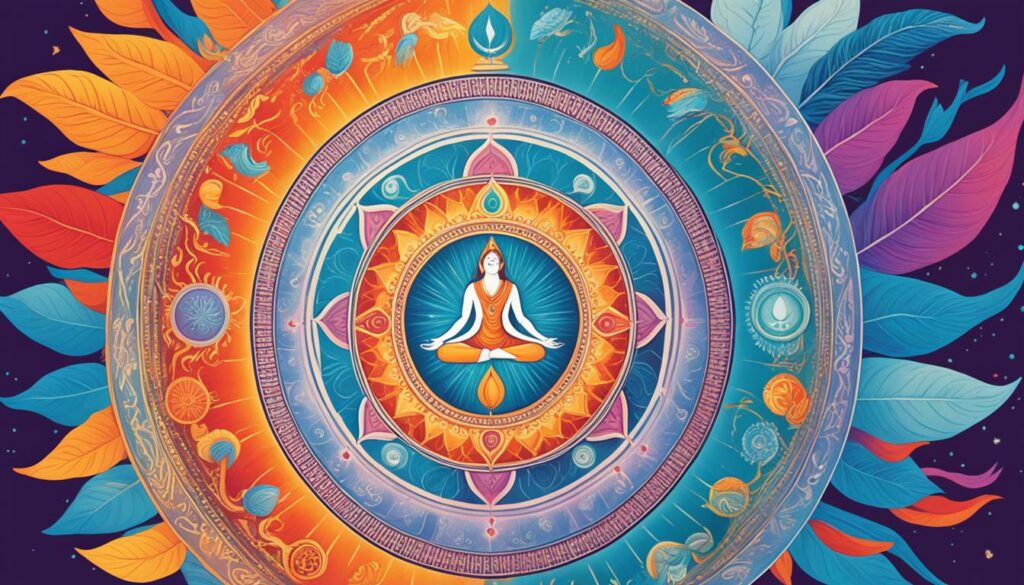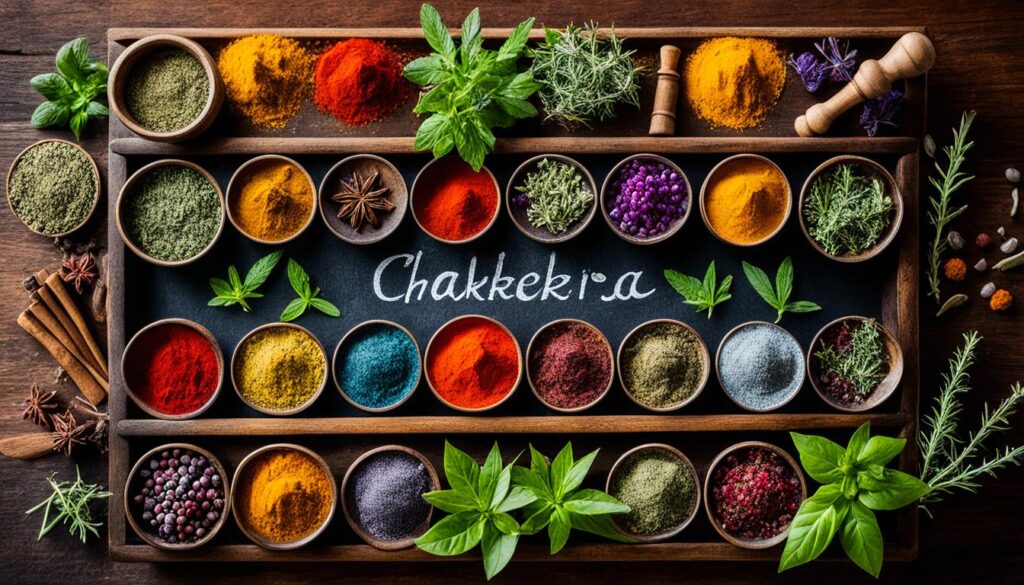The Garuda Purana is a key text in Hinduism. It’s one of the 18 essential scriptures, known as the Mahāpurāṇas.1 It is highly valued by those in Vaishnavism, a Hindu branch dedicated to Vishnu. This text is like a conversation between the god Vishnu and his bird-like carrier, Garuda. In these talks, Vishnu shares important knowledge. He talks about many things like life after death, the right way to live, and the law of cause and effect.1 It’s a roadmap for life and understanding what happens after we die. It shows how to live honorably, warns about wrong actions, and explains how to break free from the cycle of rebirth.
Key Takeaways
- The Garuda Purana is one of the 18 Mahāpurāṇa texts in Hinduism, containing over 15,000 verses on diverse topics.1
- The text is believed to have been composed between the 4th and 11th centuries CE and is categorized as a Sattva Purana, representing goodness and purity.1
- The Garuda Purana is a Vaishnava Purana, with its cosmology revolving around Vishnu and Lakshmi as the creators of the universe.1
- The text is structured as a dialogue between Vishnu and his loyal mount, Garuda, and covers a wide range of topics, including the afterlife and funeral rites.2
- The Garuda Purana serves as a comprehensive spiritual guide, offering insights into virtuous living, the consequences of actions, and the path to liberation from the cycle of rebirth.
Introduction to the Garuda Purana
The1 Garuda Purana is part of Hinduism’s Vaishnavism literature, focusing on Vishnu.1 It’s written as a dialogue between Vishnu and his mount, Garuda. Here, Vishnu shares deep wisdom and knowledge with Garuda.1
Overview of the Garuda Purana’s Significance
It’s highly revered by the Vaishnavites, a Hindu branch that worships Vishnu.1 This text discusses everything from the universe’s beginnings to how one should live, practice rituals, and what happens after death. It’s a key work in Hinduism, offering a complete guide for life.1
The Purana’s Place in Vaishnavism
Being a vaishnavite text, the Garuda Purana is deeply connected to showcasing Vishnu’s teachings. It also reveals the importance of Garuda, Vishnu’s mount, in bringing spiritual knowledge to humans through this sacred Hindu scripture.1
Origins and Historical Context
The Garuda Purana is said to come from the sage Vyasa. He compiled the Mahabharata and other key Hindu texts.1 But, no one knows exactly when it was written. Scholars think it could be from the 3rd century BCE to the 11th century CE.3 There are many versions of the text, with varied chapters and content.1 Some manuscripts are also known as “Sauparna Purana,” “Tarksya Purana,” and “Vainateya Purana.”1 The modern versions have about 8,000 verses. They are split into two parts: the Purvakhanda and the Uttarakhanda or Pretakhanda.1
Traditional Authorship and Dating
Traditionally, the Garuda Purana is linked to Vyasa, who also did the Mahabharata.1 The exact time it was written is still debated. It could be between the 3rd century BCE and the 11th century CE.3 This wide date range shows how complex the text’s history is. It also shows how the Garuda Purana has changed over time.
Surviving Manuscripts and Versions
There are many versions of the Garuda Purana, with different chapters and content.1 Manuscripts go by names like “Sauparna Purana,” “Tarksya Purana,” and “Vainateya Purana.”1 The versions we have today usually have about 8,000 verses. They’re in two main parts, the Purvakhanda and the Uttarakhanda or Pretakhanda.1 This variety shows how the Garuda Purana has evolved over time.
Structure and Contents
The Garuda Purana has two main parts: the Purvakhanda and the Uttarakhanda or Pretakhanda.1 The Purvakhanda talks about many things, like life, living, and ancient wisdom. It goes into topics such as cosmology, mythology, and ethics. It also looks at health from the Ayurvedic point of view.1
The Uttarakhanda, also called the Pretakhanda, is more focused. It mainly covers what happens after death and related ceremonies.1 This part discusses the soul’s journey, heaven, hell, and how our actions affect us after we die.
Purvakhanda (Early Section)
The first part of the Garuda Purana, or the Purvakhanda, is quite broad. It looks at cosmology, mythology, and the Vedic way of life. This section talks about what it means to live fully within the Hindu culture.1
Uttarakhanda or Pretakhanda (Later Section)
The second part, the Uttarakhanda or Pretakhanda, is more specific. It concentrates on life after death and funeral rituals.1 It includes information on the soul’s journey, different realms, and the impact of our deeds after we pass away.
Garuda Purana
The Garuda Purana is a vital Hindu text. It stands with 17 others, known as the Mahapuranas. This sacred scripture is key in the Vaishnava tradition, focused on Vishnu worship.1 It takes the form of discussions between Vishnu and Garuda, his mount. These conversations cover many areas like life after death, rites for the dead, and living well.1 It is a guide for Hindus, teaching about good deeds and the path to freedom from rebirth.
It is part of the Vishnu Puranas, with a shortened section on death and rebirth.4 Some Hindus use parts of it for funerals. It talks about what happens between lives, like Hell and Heaven.4 The Garuda Purana explains what comes next after death, funeral customs, the best time to honor the dead, and what gifts to give.4
The book has chapters on punishments for the sinful, life after death, and how to find freedom.4 It talks about Hell, the City of Yama (God of Death), and ways the cosmos connects to the body.4 The main message is that knowing yourself can lead to freedom, more than any ritual or study.4
The Garuda Purana lists 28 different Hells.5 It describes each one, including the punishment. For example, being whipped in Tamisram, facing snakes in Rauravam, and experiencing brutal beatings in Sukaramukham.5 There are sins like animal killing, adultery, and power abuse, each with their own terrible fate like burning in oil, touching hot metals, and dealing with filth.5 The punishments are detailed, from flogging and burning alive to torture with knives, fire, and different weapons in these Hells.5
Cosmology and Mythology
The Garuda Purana talks about the Hindu gods, Vishnu and Lakshmi, and how their union made the world.1 It says Vishnu represents the unchanging truth, called Brahman, while Lakshmi means the changing world, called Maya.1 This text introduces the Samkhya theory of two realities: Purusha (spirit) and Prakriti (matter). It shows they need each other to create the universe.1 Goddess Lakshmi brings life and is the source of creation, and God Vishnu is the eternal soul.1
The Role of Vishnu and Lakshmi
In the Garuda Purana, Vishnu and Lakshmi’s joining is key. Vishnu stands for what never changes, while Lakshmi is how things change, creating our world.1 This mixes with the Samkhya belief, showing how vedic cosmology sees them as the foundation of reality.1
Samkhya Philosophy and Dualism
The Garuda Purana also discusses the Samkhya theory, tying spirit and matter together in creation.1 Its focus on samkhya philosophy and metaphysical dualism shapes the story. It underlines how both male and female aspects of the divine work together.1
The Afterlife and Realms Beyond

A big part of the Garuda Purana talks about what happens after we die and the worlds we might go to. It looks at the journey a soul takes after leaving the body, explaining each step.6 The book also tells us about amazing places for good people and terrible places for the bad ones.6
The Journey of the Soul
The Garuda Purana teaches us about how our actions affect where we go after death. If we do good, we end up in heavenly places. But, if we’re bad, we face hard times in hell.7 It describes the different places souls visit after death, like the sun and beyond. There, a special being helps the soul find peace.7
Descriptions of Heaven and Hell
This book paints a clear picture of what heaven and hell are like.6 It shows that the kind of life we lived determines our afterlife. This gives us a deep understanding about good and bad deeds.6
The Influence of Karma
Understanding karma is key in this book.7 It says, strong feelings for loved ones or wealth can bring a soul back to life. It tells a story about a soul that wanted a child so much it got one in the next life.7 The Garuda Purana also mentions the paths of light and dark from the Bhagavadgita. They decide if we keep coming back to life.7
Rituals and Funeral Rites
The Garuda Purana, a sacred text, talks a lot about funeral rites. It says it’s very important to do these rites correctly. This is to help the person who has passed, moving smoothly into their next life. The text gives a step-by-step guide on how to do various rites. For example, it tells about cremation and what to do on the tenth and eleventh days after someone dies. These rituals are all about showing respect for the person who has died.
Importance of Proper Rituals
The Garuda Purana tells us how long different people should take to do their death rituals. It says a Brahmin should take ten days, a Kshatriya twelve days, a Vaishya fifteen days, and a Shudra a month.8There are special rules for when a boy dies before getting his first teeth or when a young person dies. The text stresses how these rituals are key to honoring and helping the dead move on safely to their next journey.
Guidance for the Deceased’s Transition
The text also says the Sapiṇḍa ceremony is really important and should be done after twelve days for all. Even in today’s time, it’s not good to do any rituals or accept certain things before this ceremony. The consequences can be serious.8These rules help make sure that the living can do their part to help their loved ones who have passed on.
Dharma, Ethics, and Righteous Living
The Garuda Purana talks about the afterlife. It also explores Hindu ideas such as dharma, ethics, and virtuous living. It tells us to follow dharmic principles. These are moral, ethical, and spiritual rules for good behavior. It teaches us to be honest, caring, and faithful. And that we should avoid bad deeds to prevent pain in the afterlife. It inspires people to live rightly. This way, they can reach spiritual truth and break free from rebirth cycle.
9Dharma mixes ethics, religious teachings, and societal norms. It’s closely tied to Yama, a Hindu god. Yama stands for doing right and self-control. His role moves to that of a guide. He explains about the changing and fleeting nature of life. He talks about consequences and the cycle of life and death. Yama and Dharma are joined. Dharma sets a rule, Yama checks that the rule is followed.
10 Dharma leads us to true joy and fulfillment. It directs us towards self-awareness or understanding God. It includes following dharma, gaining wealth (artha), enjoying life (kama), and finding freedom (moksha). Dharma tells us three ways to reach God or find liberation: doing our work without wanting personal gain, loving the Supreme in all situations, and gaining knowledge about ourselves and the world.10
10 Dharma lays down the laws of the universe. It also gives moral rules for us. Following these can lead us to moksha, or freedom.10
Ayurvedic and Medical Knowledge

The Garuda Purana talks about many things, including ayurvedic medicine. This is the old system of health from India. It looks at healing in a complete way. The text has a lot about illnesses, their signs, and how to treat them with herbal remedies and natural care.11
This ancient book also covers ways to keep from getting sick. It talks about different treatments and even things to boost love and protect from diseases.11 Using these traditional medical ideas can help keep both the body and mind healthy. This fits with Hindu beliefs.11
The Puranas, like the Garuda Purana, are good sources on staying healthy and healing in traditional ways.11 In the Padma Purana, specific plants like Tulasi and Amalaki are mentioned. They talk about when to use them and how.11 The Vishnu Purana adds more on the ancient health wisdom. It mentions things like what foods are good in different seasons.11
The Garuda Purana details many sicknesses and how to cure them. It looks at common issues like sinus problems and more serious things like poisoning.12 According to this text, there are five parts to treatment. This includes figuring out the problem and then finding the best medicine and diet to cure it.12
The Garuda Purana is full of ayurvedic medicine and other traditional ways to heal. This book shows how deep and broad its knowledge is. It’s a manual on how to take care of everything for overall health.111213
Architectural and Temple Guidance
The Garuda Purana teaches more than spiritual practices. It also talks about Hindu architecture and designing holy places. This text guides readers on key aspects of building a Hindu temple. It covers layout, materials, and how the temple should face.1 It explains how these parts help in rituals and make the space right for spiritual practice. By teaching how to build and keep up religious structures, the Garuda Purana ensures they follow Hindu traditions.
The Garuda Purana gives detailed advice on selecting building materials and placing the temple.1 This ensures Hindu temples are beautiful and help connect worshippers with the divine. By following these teachings, Hindu groups can construct and look after their religious structures in ways that honor the Hindu tradition’s sacred architecture and temple design and construction principles.
The Purana also notes the need for ritual spaces within temple designs. This ensures temples aren’t just buildings but places that help in Hindu rituals and ceremonies.1 Learning from the Purana’s wisdom on sacred architecture and Hindu religious structures, Hindus can make temples that are both stunning and spiritually enriching.
| Architectural Features of Hindu Temples | Key Characteristics |
|---|---|
| Layout and Orientation | Precise alignment with cardinal directions, symmetrical design, and integration of sacred spaces |
| Materials and Construction | Use of durable, natural materials like stone, wood, and metals, with intricate carvings and ornamentation |
| Ritual Spaces | Incorporation of areas for worship, meditation, and the performance of Hindu ceremonies and festivals |
| Symbolic Representation | Incorporation of Hindu deities, mythological figures, and philosophical concepts through architectural elements |
The Garuda Purana’s teachings help create temples that stand as spiritual hubs. They are central to spiritual practice and devotion, showcasing Hinduism’s deep heritage.1 Its insights on temple design and construction and Hindu religious structures keep influencing Hindu architecture. This leads to the making of structures that are both stunning and significant to the community.
Literary and Grammatical Insights
The Garuda Purana is a detailed Vedic literature. It covers sanskrit grammar, linguistic analysis, and literary genres. The text explains many types of Vedic literature like hymns, stories, and philosophy.14 It also teaches the importance of correct Sanskrit usage in religious texts and ceremonies.14 This shows Hindu knowledge is broad, including spiritual insights, practical advice, and language studies.
This vedic literature is known as a Vaisnava Purana. It’s like an encyclopedia, touching on subjects like Medicine, Astrology, Palmistry, and Metrics.14 It includes footnotes to help readers understand better, making it a key resource.14 The Purana also explains its name and how its content is organized, giving a clear picture of what to expect in this Hindu text.14
The Garuda Purana, a part of the Puranas, falls under the Mahāpurāṇas. These are placed in different categories showing their themes and views.14 By studying its literary and linguistic details, the Garuda Purana presents Hindu texts’ complexity and depth. This cements its crucial role as a knowledge and wisdom source.
Conclusion
The Garuda Purana is a key Hindu text, delving into spiritual, philosophical, and practical knowledge.15 It stands out among the 18 Mahapuranas, being highly important to Vaishnavites and all Hindus.15 This book talks about cosmology, mythology, and more. It’s a crucial tool for exploring the richness and depth of Hindu beliefs and customs.15
The Garuda Purana’s contribution is paramount. It offers a pathway to living right, finding spiritual truth, escaping rebirth. Thus, it is a cherished and influential part of Hindu literature.15 This holy text’s spiritual wisdom has deeply impacted Hinduism.15 It remains key for anyone who wants to dive into the true nature of their religion.15
FAQ
What is the significance of the Garuda Purana?
The Garuda Purana is one of 18 key Hindu texts. Known as a Mahapurana, it’s sacred, especially to those who worship Vishnu. It takes the form of a dialogue between Vishnu and his mount, Garuda. They talk about many important topics, like the afterlife, funeral customs, what’s right (dharma), and Ayurveda.
What is the relationship between Vishnu and Garuda in the Garuda Purana?
In this text, Vishnu speaks to his devoted mount, Garuda. He shares deep insights on life, making the book a valuable guide. Together, they discuss spiritual, philosophical, and practical matters. This makes the Garuda Purana a go-to for understanding life and the next one.
When was the Garuda Purana composed, and what are the different versions of the text?
Scholars are not sure of the exact date the Garuda Purana was written. They think it happened sometime between the 3rd century BCE and the 11th century CE. This text has many versions, each with its unique chapter count and content. Some versions are known by other names, such as “Sauparna Purana,” “Tarksya Purana,” and “Vainateya Purana.”
How is the Garuda Purana structured, and what are the main topics covered in its sections?
The Garuda Purana has two parts: the Early Section and the Later Section. The Early Section, Purvakhanda, covers areas like cosmology, myths, and ethical teachings. It also dives into Vedic knowledge and Ayurveda. The Later Section focuses on death rituals, the afterlife, heaven and hell descriptions, and karma’s role.
How does the Garuda Purana explore the concept of the afterlife and the realms beyond?
The text spends a lot of time exploring what happens after we die. It talks about the soul’s journey, breaking it down into stages. It describes where the good and the bad souls go. This includes heavenly rewards and hellish punishments, all governed by karma.
What other topics does the Garuda Purana cover besides the afterlife?
Besides the afterlife, the Garuda Purana has a wealth of topics. It touches on cosmology, dharma, health advice, temple-building, and Vedic literature. This text aims to be a complete resource for Hindus. It offers spiritual, physical, and cultural insights.
Source Links
- https://en.wikipedia.org/wiki/Garuda_Purana
- https://lakshminarayanlenasia.com/downloads/GarudaPurana.pdf
- https://emoha.com/blogs/busy/life-afterlife-the-mysteries-entwined
- https://sacred-texts.com/hin/gpu/index.htm
- https://www.linkedin.com/pulse/28-punishments-our-sins-garuda-purana-pravin-agrawal–qyfdf
- https://medium.com/@sutirtha38/the-garuda-purana-an-odyssey-through-afterlife-and-cosmic-wisdom-b0f091ec5023
- https://www.swami-krishnananda.org/bgita/bgita_26.html
- https://sacred-texts.com/hin/gpu/gpu15.htm
- https://goldcoasthindu.wordpress.com/2020/08/29/yama-and-dharma-two-sides-of-the-same-concept/
- https://shanmugamp.org/2019/12/05/hinduism-and-dharma-the-distinction-between-a-religion-and-a-way-of-life/
- https://www.easyayurveda.com/2016/12/29/ayurveda-puranas-upa-purana/
- https://www.speakingtree.in/allslides/never-heard-before-medical-treatments-that-are-mentioned-in-garuda-purana
- https://jaims.in/jaims/article/view/882
- https://www.exoticindiaart.com/book/details/garuda-purana-3-volumes-ide886/
- https://www.damakdam.com/blogs/blogs-for-you/exploring-the-garuda-purana-a-comprehensive-summary-for-the-common-man

